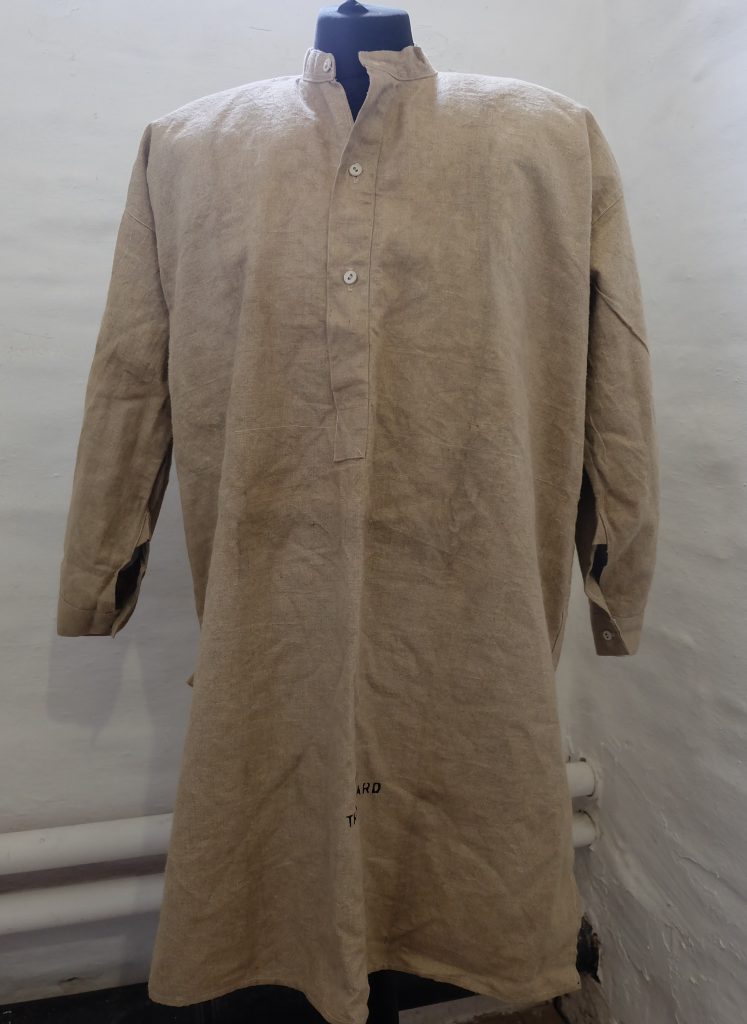30 October 2019
Explore the collection: a Vagrant’s Nightshirt
November’s Object of the Month is a nightshirt, worn by a vagrant in Knaresborough Workhouse. It dates from between 1930 and 1945.
The nightshirt is made from a coarse material, known as drabbet. It has been stamped with the initials ‘WRCC’, which stand for West Riding County Council, and the words ‘MEN TRAMP WARD’. The nightshirt was found in Knaresborough Hospital, formerly Knaresborough Workhouse, by an employee shortly before it closed down – the employee saved it and her family later donated it to Ripon Museum Trust.
The nightshirt was worn overnight by a vagrant in Knaresborough Workhouse. It is very similar to those that were worn by vagrants in Ripon Union Workhouse. When they entered the workhouse, the vagrant’s clothes were removed and fumigated at high temperatures, in a process known as ‘stoving’. They were given a nightshirt to wear overnight. This would have been worn by many other vagrants before them and was a ‘one-size-fits-all’ garment. Their own clothes were returned to them the next day.
Stoving a vagrant’s clothing helped to stop the spread of disease and lice and fleas, but there were other practical reasons why this was carried out. A newspaper report in the Knaresborough Post on 19 September 1874, shortly after the opening of the new vagrant’s accommodation at Ripon Workhouse explains that “by removing from the vagrants every vestige of clothing, the facilities afforded for searching are most effectual, and neither smoking nor writing obscene language in the wards can possibly take place. They are also prevented from tearing up their own clothing and from acting in concert for any mischievous purpose.”
Unfortunately, however, records for Ripon Union Workhouse and newspaper articles show that many vagrants did still tear up and destroy their own clothing whilst in the workhouse. This may have been to force the workhouse staff to provide them with new clothes. Vagrants who destroyed their clothes were taken in front of the Magistrates at Ripon Liberty Courthouse and usually sentenced to 14 days hard labour in Ripon or Northallerton prison.
An article in the Pateley Bridge & Nidderdale Herald, dating from 12 December 1891, reported on the trial of James Smith, who was accused of destroying his clothes and refusing to complete his work task in Ripon Union Workhouse. It reads “James Smith, 28, of no fixed residence, and an inmate of the Ripon Union Workhouse Casual Ward, was brought up in custody charged on the information of Mr. A. Burton, Master of the Workhouse, with refusing to do task work on the previous day. Prisoner pleaded not guilty. Prisoner had asked the attendant to wash his shirt, it was not normal for casuals’ shirts to be washed, but agreed to stove it. When it was given back to the prisoner, he tore it and all the other clothes on him up.” When James Smith was asked why he had torn up his clothes, he replied that they were “filthy dirty, and had not been washed for two months.”
The nightshirt can be seen on display at the Workhouse Museum in our current exhibition Rogues & Vagabonds, which explores historic and contemporary homelessness in Yorkshire. The exhibition runs until 1 December 2019.
 Workhouse Museum
Workhouse Museum